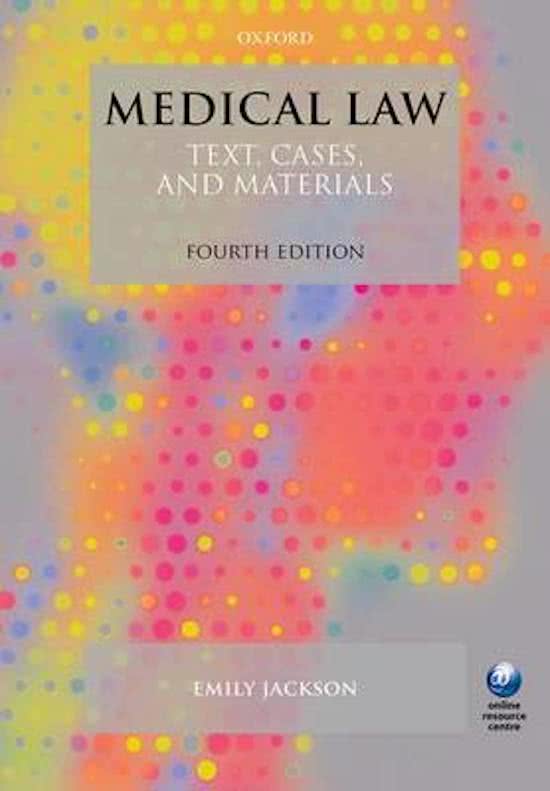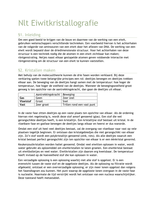Why inform patients?
One of the first principles of medical law is that patients with capacity must give consent to their
medical treatment. For consent to be valid, it must be given voluntarily.
Until recently it was thought that informing patients about a poor prognosis, possible side effects, or
the availability of alternative treatments would be likely to cause distress and confusion, jeopardizing
the patient’s recovery.
o Occasionally providing information was judged to be in a patient’s best interests: when surgical
procedures were carried out without anaesthesia, it was important for patients to prepare
themselves for the infliction of excruciating pain.
The idea that patient should have the information is only a new right given. It was common not to tell
the patient how bad the diagnosis was
Why is it important to give patients information?
o There is an imbalance of power and information.
o Patients do have some expertise as they are experts about what is right for themselves
Medical treatments have side effects and the patient is the one to say whether the side
effect happens to them or what matters most in terms of treatment.
Harry Lesser: the patient herself is the only person with the expertise necessary to make
a judgement about the tolerability of side effects and adverse consequences.
o When patients are properly informed, they choose treatments with better outcomes
o Sign of respect
o There is ambiguity over what informed consent means and patients themselves see consent
form as a bureaucratic requirement, not an opportunity for autonomous decision
The Hippocratic principle that doctors decides which treatment the patient receives has been replaced
by a partnership model of decision making. In which both the doctor and the patient have specialist
knowledge which must be shared in order to ensure that the patient makes the best possible decision
for herself.
Some ambiguity
What does ‘informed consent’ mean?
o The patient has just been informed
o Or does the patient have to be informed in terms of understanding
It is difficult for doctors to work out prospectively how much disclosure is necessary in order to avoid
liability in negligence. Because of this uncertainty, there is a danger that doctors might feel obliged to
disclose too much information to patients.
o It may prompt patients to attach disproportionate importance to a very remote risk and as a
result might refuse treatment that is overwhelmingly likely to be both safe and successful.
In practice, the process of obtaining patient consent for invasive treatments and diagnostic procedures
is commonly limited to one or two encounters before the procedure takes place.
Would take time and cost money.
Rob Heywood: There is a danger that lengthy and elaborate forms detract from the consent process
itself, a process which should discuss the treatment its risks and benefits.
Patients themselves see the consent form as a bureaucratic requirement, not an opportunity for
autonomous decision
o Very few patients think the purpose of the consent form is to enable them to make an informed
choice about treatment.
, o ‘Has the patient been consented?’ – its passive and the patient is not viewed as actively
pursuing their treatment – people don’t actually know what they are signing.
Robert Heywood, Ann Macaskill and Kevin Williams: Few patients mentioned or even implied that
consent was about their right to self-determination, instead it seems to be a means to an end.
o The patients in this study failed to make the link between the actual signing of the consent form
and the information that was given to them in order that they could make an informed choice.
Andrea Akkad: many patients did not see written consent as functioning primarily in their interests nor
as a way of making their wishes known.
Onora O’Neil: A person who is ill or injured is highly vulnerable to others, and highly dependent on
their action and competence. Robust conceptions of autonomy may seem a burden and even
unachievable for patients, mere choosing may be hard enough.
o Neil Levy: Patients may be asked to make a series of decisions – they can be expected to suffer
decision fatigue and a consequent decline in the quality of their judgements.
Arthur L Caplan: Strongly suggesting a course of prevention, care or palliation in the face of a patient’s
expression of a different choice may be paternalistic but it is a projection of what is good based not
upon the doctor’s values but upon expertise and experience.
Legal protection for informed consent
Battery: If there is no consent then it is an assault/battery. This will be very rare.
Chatterton v Gerson: In my judgment once the patient is informed in broad terms of the nature of the
procedure which is intended, and gives her consent, that consent is real, and the cause of the action on
which to base a claim for failure to go into risks and implications is negligence, not trespass.
o Birstow J held that consent would be real as long as the patient had been informed in broad
terms about the nature of the procedure.
o It is no defence to a charge of battery that the doctor was acting in the best interests of her
patient, or that she exercised all reasonable care and skill.
Battery can also be assault
R v Tabassum: Someone who persuaded women that he was a medical person and performed breast
examination. As he did not have a medical qualification there was no consent and so it was an assault.
o Consent was given because they mistakenly believed that the defendant was medically
qualified… and that in consequence, the touching was for a medical purpose. As this was not so,
there was no true consent’.
The Creutzfeldt Jakob Disease Litigation – May J: There is assault and battery when there is a physical
violation of a person’s body without true consent. A doctor who fails to tell a patient about a small risk
inherent in a proposed treatment does not intend to injure her.
Appleton v Garett: a dentist had deliberately carried out extensive and wholly unnecessary dental
treatment for personal financial gain, and had been struck of as a result.
o His intentional and fraudulent wrongdoing may have helped to persuade the court to find him
liable for battery rather than negligence.
Negligence
For those cases where you consent but you are not informed of a possible side effect. There is a duty of
care to inform the people of the side effects.
Accepted to be part of the ordinary duty of care doctors owe to patients. But involves a positive duty to
act? Most of the difficulties arise in relation to standard of care and causation.
The duty of care includes a duty of reasonable disclosure, but who decides what is reasonable?
o What doctors generally judge to be reasonable (Bolam): doctor should disclose that which a
reasonable disclosure doctor would disclose.
Inappropriate – We should act according to patient.
, o What the reasonable patient would want to know (objective, patient centred): the doctor
should disclose what a reasonable objective would want to know.
Problematic because it assumes that patients are all the same and they are not.
We bring our family decisions/history to bare on ours. What we think matter varies
o What this particular patient would want to know (subjective, patient centred)
In practice it is difficult for doctors: how will the doctor know what matters to the
person?
Where is English Law on this?
Pre-2015 UKSC case: Sidaway v Board of Governors of Bethlam Royal Hospital – Not told about small
risk. HL unanimously rejected Mr Sidaway’s claim that the failure to warn her of this risk had been
negligent.
o According to Lord Diplock, the Bolam test applied to all aspects of a doctor’s Duty of Care and
he saw no reason to treat advice differently from diagnosis and treatment: the doctor’s
disclosure should therefore be judged by its conformity with responsible medical practice.
o Lord Scarman = reasonable patient test. “The test of materiality is whether in the circumstances
of the particular case the court is satisfied that a reasonable person in the patient’s position
would be likely to attach significance to the risk.
o Lord Templemen believed disclosure was ‘primarily a matter of clinical judgement’
Pearce v United Bristol Healthcare NHS Trust: If there is a significant risk which would affect the
judgment of a reasonable patient, then in the normal course it is the responsibility of a doctor to
inform the patient of that significant risk, if the information is needed so that the patient can
determine for him or herself as to what course he or he should adopt. The doctors called on behalf of
the defendants did not regard that risk as significant, nor do I…
o The risk that was at issue was a small risk (0.1–0.2%) of still birth at the end of her pregnancy. It
is possible that you would want to know about this risk regardless of how small given that the
woman carries the child for 9 months. (move towards the reasonable patient test)
Wyatt v Curtis: Woman who was pregnant and not having been told that having chicken pox is harmful
for the child.
o The background risk of a potentially catastrophic abnormality may well be both substantial and
grave, or at least sufficiently real for her to want to make an informed decision about it.
o Sedley LJ: What is substantial and what is grave are questions on which the doctor’s and the
patient’s perception may differ, and in relation to which the doctor must therefore have regard
to what may be the patient’s perception.
Birch v UCL Hospital NHS – Cranston J: unless the patient is informed of the comparative risks of
different procedures she will not be in a position to give her fully informed consent to one procedure
rather than another.
Reasonable patient test?
Montgomery v Lanarkshire Health Board
Woman with diabetes who was going to have a large baby. She was not warned about the risks of
natural delivery with broad shoulders. The Supreme court found in favour of the patient.
Strongly patient autonomy judgement
o Lord Kerr and Reid: Since Sidaway, however, it has become increasingly clear that the paradigm
of the doctor patient relationship implicit in the speeches in that case has ceased to reflect the
reality and complexity of the way in which healthcare services were provided, or the way in
which the providers and recipients of such services view their relationship
o One development which is particularly significant in the present context is that patients are now
widely regarded as persons holding rights, rather than as the passive recipients of the care of
the medical profession…





